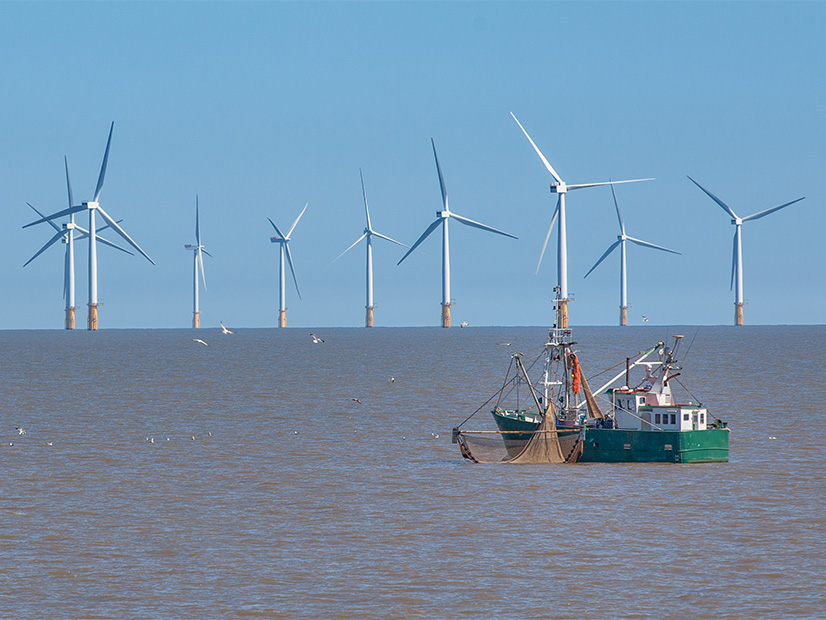
A new report by two federal agencies and a fishing industry group concludes there are major gaps in scientists’ understanding of offshore wind power’s impact on marine ecosystems.
The report focuses on U.S. waters, where only a handful of turbines now stand, but draws in part on knowledge gathered in other countries, where OSW farms have been operating for years.
Opponents of offshore wind development have criticized the rush to build without a complete understanding of the impact on fisheries before research is complete, or even begun. (See Fishing Impact Seen on SouthCoast Wind Project and NJ Outlines OSW Research Projects amid Ocean Enviro Anxiety.)
OSW supporters counter that the new source of large-scale carbon-free electricity is crucial to addressing climate change.
But neither of these opinions are in the report; instead, it is a straightforward presentation of what is known and unknown at the start of the OSW era in the U.S.
Multiyear Effort
The report by the Bureau of Ocean Energy Management (BOEM), the Northeast Fisheries Science Center of the National Ocean and Atmospheric Administration (NOAA) and the Responsible Offshore Development Alliance (RODA), is an outgrowth of the groups’ 2019 memorandum of understanding to collaborate on the process of OSW development on the U.S. Outer Continental Shelf.
They have been working on the report since their Synthesis of Science workshop in October 2020 drew more than 550 participants from a wide range of backgrounds and disciplines.
The analysis deals primarily with fixed-turbine technology; floating-turbine technology, which is less mature, will be addressed in a separate project led by RODA.
The 388-page report lists existing knowledge; known gaps in knowledge; commercial and recreational fishing industry opinion; and recommendations for future study on the impact on habitats, oceanographic processes (changes in temperature or salinity), ecosystems and fisheries.
The report examines the noise and disruption of construction, the lesser noise of operations and the oceanographic effects of turbine blades spinning above the surface. The impact on individual species — from plankton and small fish to the commercially important groundfish and large marine mammals — is not documented. Whether OSW development will have cascading effects up and down the food chain is also unknown.
As a result, the report makes no predictions on the effect on the fishing industry or waterfront communities whose culture and economy are linked to the fisheries.
The report does predict that blue mussels will colonize the tower foundations and cites limited evidence of decreased squid abundance near the five towers of the Block Island Wind Farm, the first commercial OSW project in the U.S. Pile driving noise is known to cause death or hearing injury in fish, it notes.
Seeking Knowledge
RODA has criticized the OSW development process repeatedly, not least by challenging BOEM’s approval of the Vineyard Wind I project in federal court in September 2021.
But RODA’s March 30 announcement of the report’s release is clinically neutral, with no criticism leveled or demands made.
RODA Research Director Fiona Hogan told NetZero Insider that there was no messaging in the report because its purpose was to compile for the first time a summary of what is known and unknown about the ecological effects of offshore wind.
“We’re unaware of any effort that has looked at the entire range of impacts in one place,” said Hogan, a co-author of the report.
The report can serve as a resource for anyone who wants to learn more, Hogan said. But it states bluntly that an enormous amount of research is still needed to build a better understanding of OSW’s impact on the ocean and its fisheries.
The report notes that time is limited, as the ability to gather data after construction could be impaired. Aerial surveys may be impaired, particularly on cloudy days, because aircraft must stay well above the rotor blades; surveys from the surface may be limited by low-swinging blades; and subsurface surveys may be impaired by the new underwater infrastructure.
It implies the opportunity has passed for a regional science plan that could have provided an understanding of OSW’s cumulative impacts before construction starts.
“Our ability to detect the impact is impacted,” Hogan said. “That’s why we need ongoing monitoring and research.”
The report takes note of the fishing industry’s concerns over BOEM’s approach in analyzing projects on an individual rather than cumulative basis. “The environmental and economic effects will not be isolated, and fishing communities have suggested the scale of analysis should match that of fisheries and ecosystem management practices,” the report said. RODA made the same point repeatedly in a motion for summary judgement filed in late 2022 in the Vineyard Wind case.
BOEM is the lead agency in the effort to reach President Biden’s goal of 30 GW of OSW by 2030.
NetZero Insider asked BOEM for response to the report, and asked whether it planned to make any changes in its approach as a result. BOEM responded that it had asked the National Academies of Sciences, Engineering and Medicine to form the Standing Committee on Offshore Wind Energy and Fisheries to encourage the kind of dialogue that began at the 2020 workshop.
NOAA had no comment beyond a March 30 news release quoting Andy Lipsky, head of the wind energy team at NOAA’s Northeast Fisheries Science Center and a co-author of the report:
“We are pleased to have been a part of this project and look forward to working with our partners on its next iteration, a series of workshops focused on fisheries and floating offshore wind energy. This collaboration was a great success and truly helped us as we developed a joint survey mitigation strategy with the Bureau of Ocean Energy Management. It also helps us define and begin developing the new kinds of monitoring required to continue our long-term data streams on ocean life as well as needed research on how offshore wind energy changes marine habitats and fisheries.”

